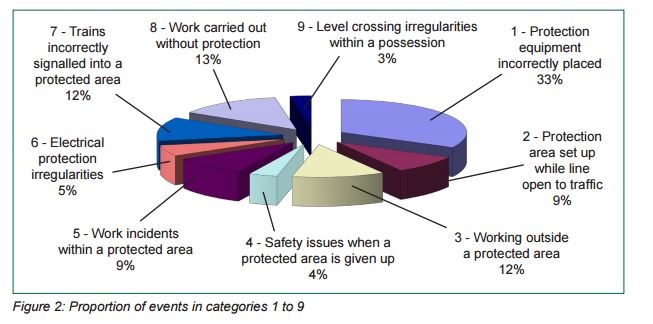21.08.15
Poor safety arrangements put track workers at risk almost every day
Significant irregularities in safety arrangements for track workers during infrastructure engineering work puts staff at risk between three and five times each week on average, an RAIB investigation has found.
Over the course of a two-year data collection period, the investigator found that many of the operating irregularities were “significant in nature” and their occurrence was “frequent and not reducing”.
Network Rail records defined types of “undesirable occurrences” and “operational incidents” on the national network in the daily incident reports produced by its National Operations Centre, based on information received from operations control offices on each of its routes.
RAIB duty co-ordinators reviewed these every day, and between April 2011 and April 2013, identified a total of 714 events involving operating irregularities during infrastructure engineering work.
Around 71% (440 events) of the categorised events fell into one of nine ‘significant’ event categories.
Events involving errors with the positioning of protection and other equipment, such as detonators, possession limit boards and work site marker boards, occurred most frequently with 144 events (33% of all significant events).
RAIB said: “Because of where the equipment was placed (for instance on the wrong line, at the wrong signal or on the wrong side of signals or points) there was a significant likelihood that the setting up was carried out on sections of open line. Some of the individuals undertaking this work were probably unaware of the risk of being struck by a train.”
Other “significant” events included working outside a protected area; protected area set up while the line is open to traffic; safety issues when a protected area is given up; work incidents within a protected area; electrical protection irregularities; trains incorrectly signalled into a protected area; work carried out without protection; and level crossing irregularities within a protected area.

The remaining categorised events (177 events) divided into four other categories: trains prevented from running for technical reasons; procedural issues associated with infrastructure engineering work; running through points; and collisions with relatively lightweight protection equipment.
The RAIB has considered the need for additional work to further understand these safety issues and examine control measures that would mitigate the associated risks. However, it has recognised that Network Rail’s implementation of a major track safety initiative (PDSW, Planning & Delivering Safe Work) will change current safety arrangements and potentially affect the type of irregularities that will occur in the future.
Because of the PDSW initiative, the investigator has decided that “such additional work would not be appropriate at this time”.
However, it has observed that while recognising Network Rail’s intention to include a post-implementation review in its programme for PDSW, this initiative has not been fully implemented and its benefits have yet to be verified.
Therefore, Network Rail should ensure the post-implementation review includes the collection of information on events that are indicative of irregular working during infrastructure engineering work.
“It should then review this information to verify that the initiative has yielded the benefits intended and, if not, to identify and implement measures to remedy this,” said RAIB.
Additionally, the PDSW initiative does not plan to introduce changes to a number of important roles that are involved in the protection of those carrying out work on the railway, including the signaller, persons in charge of the possession and electrical control operators.
The investigator said it is likely that PDSW’s implementation “may not bring significant benefit in a number of important areas of risk”.
RAIB has asked Network Rail to develop an action plan to reduce this risk. As a minimum, consideration should be given to ways of reducing the likelihood of: protection being set up when lines are open to traffic; errors when arranging for work to be carried out on or near electrical traction supply equipment; the signalling of trains into protected areas; and irregularities involving the operation of level crossings within protected areas.
(Top image: c. Alvey and Towers)